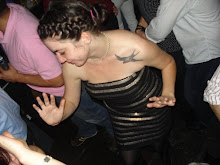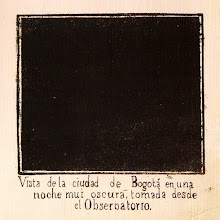Sogamoso is about 3 hours outside of Bogota on the bus. The bus journey is excellent, passing through the Sabana of Bogota and lots of wee towns and rolling plains. Thanks to said rolling plains i whipped out the camera to take a few scenic shots and somehow LEFT IT ON THE BUS LIKE A BIG EEJIT. Poor show. So you will just have to imagine the glories of Boyaca until i go on the rob from Mark's photos. In Sogamoso we stayed in a classic crappy 70's hotel with horrendous bedspreads and ancient telly, with no hot water in the showers and lots of odd figurines of fruit-sellers and things dotted around the lobby. Time spent in this hotel was kept to a bare minimum. We arrived quite late so spent the evening in a cafe tanning beers, i got IDed again which was undignified especially considering the vast droves of underage teens swanning about with Del Boy cocktails in hand, FLAUNTING the age of consent while perfectly innocent, positively decrepit 24 year olds get mercilessly asked for proof of age. Anyway the next morning we rounded up the delights of Sogamoso with breakfast in another superb 70's establishment, wood panelling and red melamine tables and sad pictures of Jesus accompanied our eggs with spring onion and tomato.
Cheerio Sogamoso (original Chibcha name Suamox meaning "City of the Sun"), hellaw Mongui. Mongui rocketed straight in there as once of the loveliest towns i've visited in Colombia. It's away up in the mountains, with steep cobbled streets and whitewashed houses with balconies dripping with geraniums and campesinos in ruanas (a poncho-esque blanket with hole for heid) leading cows over a crumbling stone bridge over a clear river. The air is clean and pure, and the whole village smells of flowers and eucalyptus trees.
Mongui is named after Montjuic, which if i remember correctly is a part of Barcelona reached by cable cars and funiculars and things. It is famous (no joke) for the manufacture of footballs, and supposedly somewhere in the town they have the biggest football in the world. We did not manage to find this. However as a consolation, here is a photo of a really big football made by the people of Mongui:
 After such classic pueblo activities as eating a giant set lunch, visiting the museum of religious art and asking irreverent questions about Catholicism
After such classic pueblo activities as eating a giant set lunch, visiting the museum of religious art and asking irreverent questions about Catholicism(ah something interesting from the muesum: the extremely youthful member of the tourist police who gave us the tour showed us this giant nativity scene, once opulent and dripping with gilt and obese cherubs but now sitting rather dustily in the corner of a disused convent. For decoration the thing was inlaid with big pearly shells, mirrors and in pride of place at the top six inexplicable blue and white china plates. Our guide explained that the plates were from Japan and Italy respectively, and the mirrors from Arabia or somewhere equally exotic, and the shells from the Caribbean i think. I'm sure you know i'm not a religion hand but i found it quite touching, that the things of greatest value were those that had travelled the furthest from all corners of the globe, and here they were being very carefully plastered into a totlly kitsch nativity scene by some criollo monks in the 17th century. Can you imagine the difficulty involved in transporting a plate from Japan to Colombia in the 1600s?)
and wandering around looking for a hostel in the blazing sun and attaining classic "quemaduras boyacenses" (the Boyaca suntan - a red stripe across the nose and cheeks sported by both locals and visitors alike thanks to the evil Andean sun) we settled in for some beers.
There was a fiesta in the town to celebrate the Virgen del Carmen (virgen of bus drivers, taxistas and all those who labour in the transport trade) and earlier on there had been a procession round the plaza with a Virgin carried on the shoulders of some locals while women sang melancholy songs and flung rose petals around while at the front of the procession a jaunty and extremely elderly brass band belted out the tunes led by a wee boy swinging one of those balls of incence in overenthusiastic 360 degree circles. So later on there was another band cracking out the carranga, typical music of the region. I haven't got the facilities to upload it but i strongly suggest you pap "carranga" into Youtube and experience this for yourself, it's great to dance to.
We'd gone to a shop in search of some empanadas and had bumped into a man who's given us directions to a hotel earlier. Delighted to see a crew of shifty foreigners, the wee dude starts us off on the best night ever and we have a beer with him and his pal before braving the nippy evening to head to the plaza for a spot of dancing. A number of speechless locals look on in horror as we dance away to the musica carranguera, Mark proving a particular favourite with the hilariously lecherous old ladies of Mongui. Hotel man then gets me to go up and speak to the whole town (through a microphone, beside lots of men in ruanas with tiny guitars), telling them i am Scottish and pure love small-town parties. Cue lots of toasts to The Scots! (Cherie and Mark were loving being Scottish for the night) who know how to dance sabroso!!
Yikes then we went to the bakery which had been transformed into a den of dancing and iniquity, all set to the background of twangy, incessant carranga. Here we were introduced to half the town and set about dancing with as many of them as possible, in between getting given free drink left right and centre. This went on until the police (among them our cheery guide from the religious art museum) arrived and turned the music off and suggested it was time for bed, but not before we had stggered our way up a cobbled street to a pizza parlour where Cherie's spirited argument with a chap (the cousin of the owner of the bakery, i believe) provided much late-night entertainment for the waiting customers. Finally we fall into bed, drunk and happy and adopted Boyacenses to the core.
Next morning, hangovers and bus journeys back to Bogota await, but before that we are treated to a cheery wave from one of our pals from last night, an old buffer who seems to have been in the pub non-stop and beckons us in to begin it all again. But like the responsible (and hungover) kids we are we had for the bus stop, via the baakery for some breakfast where everyone greets us as los escoceses and demands that we return as soon as possible. Mongui and Boyaca - i think i'm in love with you.



No comments:
Post a Comment